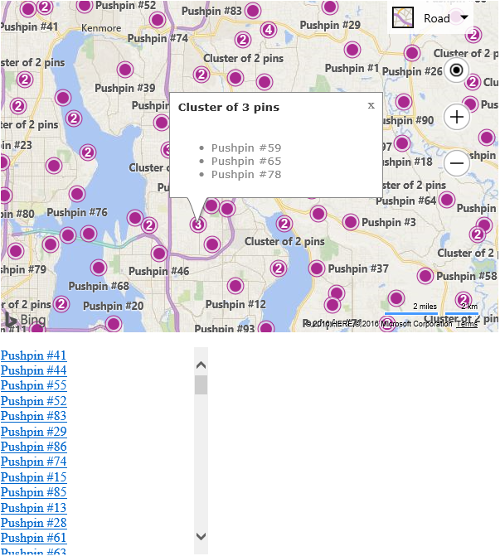Note
Access to this page requires authorization. You can try signing in or changing directories.
Access to this page requires authorization. You can try changing directories.
Note
Bing Maps Web Control SDK retirement
Bing Maps Web Control SDK is deprecated and has been retired for all free (Basic) account customers. Enterprise account customers can continue to use Bing Maps Web Control SDK until June 30th, 2028. To avoid service disruptions, all enterprise account customers using Bing Maps Web Control SDK will need to be updated to use Azure Maps Web SDK by June 30th, 2028. For detailed migration guidance, see Migrate from Bing Maps Web Control SDK and Migrate Bing Maps Enterprise applications to Azure Maps with GitHub Copilot.
Azure Maps is Microsoft's next-generation maps and geospatial services for developers. Azure Maps has many of the same features as Bing Maps for Enterprise, and more. To get started with Azure Maps, create a free Azure subscription and an Azure Maps account. For more information about azure Maps, see Azure Maps Documentation. For migration guidance, see Bing Maps Migration Overview.
This example shows how to dynamically create a list of the pushpins that are currently displayed in the clustering layer and also link each list item back to the clustered pushpin. When any pushpin, clustered pushpin or item in the list of clicked a corresponding infobox will be displayed on the map.
<!DOCTYPE html>
<html>
<head>
<title></title>
<meta charset="utf-8" />
<script type="text/javascript">
var map, clusterLayer, infobox;
function GetMap() {
map = new Microsoft.Maps.Map('#myMap', {});
//Add an infobox to the map.
infobox = new Microsoft.Maps.Infobox(map.getCenter(), { visible: false });
infobox.setMap(map);
Microsoft.Maps.loadModule("Microsoft.Maps.Clustering", function () {
//Create a clustering layer
clusterLayer = new Microsoft.Maps.ClusterLayer(createCustomPushpins(100), {
clusteredPinCallback: createCustomClusterPushpins,
callback: createPushpinList
});
map.layers.insert(clusterLayer);
});
}
function createCustomPushpins(size) {
//Generate random pushpins within the map bounds.
var pins = Microsoft.Maps.TestDataGenerator.getPushpins(size, map.getBounds());
for (var i = 0; i < size; i++) {
//Create a title for each pushpin.
pins[i].setOptions({ title: 'Pushpin #' + i });
//Add handler for the pushpin click event.
Microsoft.Maps.Events.addHandler(pins[i], 'click', pushpinClicked);
}
return pins;
}
function createCustomClusterPushpins(cluster) {
//Create a title for the cluster.
cluster.setOptions({
title: 'Cluster of ' + cluster.containedPushpins.length + ' pins'
});
//Add handler for the cluster click event.
Microsoft.Maps.Events.addHandler(cluster, 'click', pushpinClicked);
}
function pushpinClicked(e) {
//Show an infobox when a pushpin is clicked.
showInfobox(e.target);
}
function createPushpinList() {
//Create a list of displayed pushpins each time clustering layer updates.
if (clusterLayer != null) {
infobox.setOptions({ visible: false });
//Get all pushpins that are currently displayed.
var data = clusterLayer.getDisplayedPushpins();
var output = [];
//Create a list of links for each pushpin that opens up the infobox for it.
for (var i = 0; i < data.length; i++) {
output.push("<a href='javascript:void(0);' onclick='showInfoboxByGridKey(", data[i].gridKey, ");'>");
output.push(data[i].getTitle(), "</a><br/>");
}
document.getElementById('listOfPins').innerHTML = output.join('');
}
}
function showInfoboxByGridKey(gridKey) {
//Look up the cluster or pushpin by gridKey.
var clusterPin = clusterLayer.getClusterPushpinByGridKey(gridKey);
//Show an infobox for the cluster or pushpin.
showInfobox(clusterPin);
}
function showInfobox(pin) {
var description = [];
//Check to see if the pushpin is a cluster.
if (pin.containedPushpins) {
//Create a list of all pushpins that are in the cluster.
description.push('<div style="max-height:75px;overflow-y:auto;"><ul>');
for (var i = 0; i < pin.containedPushpins.length; i++) {
description.push('<li>', pin.containedPushpins[i].getTitle(), '</li>');
}
description.push('</ul></div>');
}
//Display an infobox for the pushpin.
infobox.setOptions({
title: pin.getTitle(),
location: pin.getLocation(),
description: description.join(''),
visible: true
});
}
</script>
<script type='text/javascript' src='http://www.bing.com/api/maps/mapcontrol?callback=GetMap&key=[YOUR_BING_MAPS_KEY]' async defer></script>
</head>
<body>
<div id="myMap" style="position:relative; width:600px; height:400px;"></div>
<br />
<div id="listOfPins" style="max-height:250px;width:250px;overflow-y:scroll;"></div>
</body>
</html>
Running this code in a browser will generate 100 random pushpins, each with a different title value. All pushpins, including clustered pushpins have a click event on them which opens up an infobox. An infobox for a clustered pushpin shows a list of all the pushpins that are within that cluster. Below the map a list of all pushpins that are currently displayed on the map is shown. Clicking on any of these will also open up the corresponding infobox on the map.
